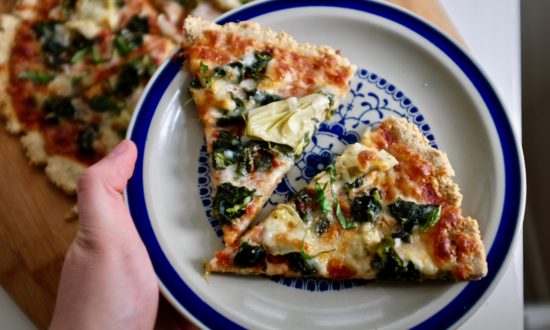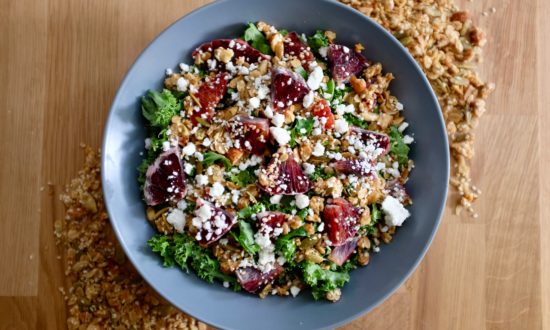Week 2 of the Top 10 Foods for Runners series! Hooray! Last week, we discussed the benefits of nut butter (more specifically, almond butter) and lots of tasty ways to add it to your diet.
But we’re moving on! This week’s top 10 pick is… Eggs! As in the “which came first” question. I’m not here to answer whether the chicken or the egg came first, but I am here to let you know why eggs belong on the Top 10 list.
Vegans and egg haters, not to worry! Excluding a few of these Top 10 foods from your diet is totally fine. That’s why it’s a Top 10 list, not an “If you don’t eat this food you’ll never be a successful runner” list. Just make sure to supplement the nutrients found in these non-vegan/vegetarian foods with something else, because these nutrients are important for healthy runners. But I’m guessing you already knew all that 😉
If your diet does include eggs, that’s also great news! I’m sure you’ve noticed that in grocery stores, you don’t just go to the refrigerated part labeled “eggs” and pick up one of all identical containers labeled “eggs.” No no, it’s much more complicated than that. You have your choice of small, medium, large, extra large and jumbo eggs. There are standard cage eggs (the ones that come in the nondescript styrofoam containers), cage-free, free-range, organic, omega-three fatty acid, etc. Not to mention some are white-shelled and other are brown.
It’s entirely overwhelming. My advice, just buy your own chickens and get eggs that way. Better yet, become friends with someone who has chickens. I’m only sort of kidding. If you are chickenless like me, here’s a few quick tips to figuring out which eggs to buy.
Tips for buying eggs
- There is no nutritional difference between white and brown eggs (why do I always feel like the brown ones are healthier?)
- No matter what type of egg you buy, they all have good sources of protein and nutrients that promote brain and eye health.
- Omega 3 eggs come from chickens that have been fed fatty acids in the form of flax seeds, algae, and/or fish oil. They can be a little healthier, but experts say you’re better off just including plenty of fish, nuts, and seeds in your diet.
- Organic eggs have to come from uncaged hens that have access to the outdoors and are free of pesticides and fertilizers. Organic is different from other claims because it is a strict legal definition. So when you’re buying organic, you know what you’re getting.
- Vegetarian is a voluntary term that means the hens were fed no animal protein. That means their diets consisted of mostly corn and soybeans. Since hens are scavengers, when they have access to the outdoors they tend to seek out worms and bugs. Therefore, there’s a good chance vegetarian-fed hens do not spend any time outside.
- Cage-free means chickens were raised indoors, but have unlimited access to food and water. However, since there is no regulation on how much space chickens need, they can be packed in as tightly as possible.
- Free-range chickens have shelter, but they also have access to the outdoors. Unless they are certified humane, there is no regulation on how long the chickens need to be outside for. Besides slightly-raised omega 3 levels (and the moral benefit of contributing to happier chickens), the difference between free-range and others have no impact on your health.
What’s so great about eggs?
Although eggs have gone from evil to good about a thousand times over the past century, I think we’ve finally landed on good for good (ha). The evidence of the health benefits eggs provide can no longer be ignored!
- Protein: One egg contains about 10% of your daily protein! Short of human breast milk (ew), egg protein is the most complete food protein. If you’re wondering what the heck that means, so was I. It means that egg protein is easy to absorb and full of crucial amino acids muscles need to promote recovery.
- Low in calories: One egg only has about 80 calories.
- Vitamin K: Just one egg contains about 30% of your daily vitamin K, which is needed for healthy bones.
- Choline: Eggs contain choline, a brain nutrient that helps with memory. People who eat higher levels of choline also have a lower risk of breast cancer.
- Lutein: Eggs contain lutein, a pigment needed for healthy eyes.
- Other nutrients: Eggs are also high in vitamins A, B12, and D, and phosphorous.
- Eggs in the past have been the bad guy due to their cholesterol levels. It’s now better understood that total fat consumption, especially saturated fat, is what drives up your blood cholesterol levels. Nowadays we’ve discovered that moderate egg consumption poses no heart-health risks. Nutrients in the yolk can actually help protect against heart disease.
Recipes
Since everyone here probably knows how to eat eggs (hard boiled, scrambled, sunny-side up, over-easy, etc), I’ve got a few recipes here in case you need some egg-spiration (lol) how to fit more eggs in your diet! Also, a few tips on how to cook eggs. You’d be surprised how many adults (me too on occasion) have to google how to cook an egg. No shame in that, props to you for cooking your own eggs!
- Hard-boiled: Place eggs in a pot and cover with water, at least an inch above the eggs. Bring to a boil and remove from heat. Let sit for ten minutes. Transfer eggs to ice-cold water to stop the cooking process.
- Soft-boiled: Bring water to a boil. Lower eggs into water and reduce to a gentle boil. Cook for 6.5 minutes then transfer to ice-cold water. Be gentle when cracking the shells and start from the bottom.
- Scrambled: Whisking is important! Make sure to get plenty of air in those eggs. Season with salt and pepper. Cook over a low temperature, scraping every so often until all the liquid is gone. Remove from stove *slightly* undercooked because scrambled eggs continue to cook a little afterward.
- Sunny-side up: Use a small amount of olive oil and heat small pan to medium/low heat. Cover with a lid and cook until all the whites are firm. Slide onto a plate and season with salt and pepper.
- Over-easy: Use a small amount of olive oil and heat a small pan over a medium/low heat. Add egg and cook until bottom is set. Flip over, careful not to break the yolk, and cook for about 15 seconds and flip over again. Slide onto a plate and season with salt and pepper.
- Over-medium: Same as over-easy, just once flipped the first time cook for a minute, not 15 seconds.
- Over-hard: Same as over-medium, just once flipped the first time cook for two minutes, not one.

Caramelized onion omelet
Ingredients
- 1 yellow onion, halved and thinly sliced
- 1 tbsp olive oil, plus more for cooking
- 1 tsp honey
- 2 cups fresh spinach, chopped
- 6 eggs
- 1/2 cup crumbled feta
- salt and pepper
Instructions
-
In a large pan, heat 1 tbsp olive oil.
-
Add onions and season with salt and pepper. Once onions start to become translucent, add honey. Stir often until onions begin to caramelize (turn dark in color). If pieces start to stick to the pan, add a few spoonfuls of water and continue to cook until onions are 1/4 of the size of when you started cooking.
-
Remove onions from pan and add spinach, cooking a minute or so on a low temperature until wilted and bright green. Remove from pan.
-
Wash pan and heat a small drizzle of olive oil (or butter or nonstick spray) to a medium heat. Vigorously whisk eggs in a medium bowl to incorporate air. Season with salt and pepper.
-
Tilt the pan so the oil is evenly distributed. Pour in half the eggs and let the bottom set (it should do so almost immediately). Taking a spatula, lift some of the cooked egg and tilt the spatula so the uncooked eggs can run underneath.
-
Continue this method, moving around the pan, until no visible liquid remains, Place half the onions, spinach, and feta on one side of the omelet. Fold top over and slide onto a plate. Repeat with rest of ingredients. Serve immediately.
Cornbread breakfast bowl
Ingredients
- 4 slices cornbread (about 3 cups)
- 1 tbsp olive oil, divided
- 1 cup chopped kale, packed
- 2 cloves garlic, smashed
- 1 tomato, cut into 16ths
- 1 avocado, sliced
- 2 eggs
- salt and pepper
Instructions
-
Heat 1/2 tbsp olive oil in a pan over medium heat.
-
Roughly chop cornbread and add to pan. Cook for a few minutes until warm and slightly crispy. Transfer to two bowls.
-
In the same pan, add a drizzle of olive oil. Add garlic and kale, mixing frequently until kale is bright green. Remove smashed garlic and add kale to the bowls.
-
Add a drizzle of oil to the pan. Once it reaches a medium heat, add the tomatoes and cook on each side until caramelized (golden brown). Transfer to the bowls.
-
Add a small drizzle of olive oil and cook eggs to your liking (I cooked mine over-medium). Season with salt and pepper and add to bowls. Divide avocado slices between bowls and serve immediately.

Breakfast (sandwich) of champions
Ingredients
- 2 slices sturdy whole grain bread
- 3 tbsp mayo
- 1 tbsp fresh basil, chopped
- 1 tbsp sun-dried tomatoes, chopped
- 2 small sweet potatoes, peeled
- 3 eggs
- 1 tbsp olive oil, plus more for cooking eggs
- 2 slices provolone cheese
- 6-8 slices turkey/chicken
- 4 slices tomato
- 1/2 cup fresh spinach
- 1/2 avocado, sliced
- salt and pepper
Instructions
-
In a small bowl, mix together mayo, basil, and sun-dried tomatoes. Set aside.
-
Using a cheese grater, grate the sweet potatoes. Place grated sweet potatoes on two paper towels and use to squeeze out any extra moisture.
-
Heat 1 tbsp olive oil in a medium pan. In a medium bowl mix together sweet potato and one egg. Form 4 patties and add to pan.
-
Cook until golden on each side. Drain on paper towels and season with salt and pepper.
-
Spread mayo on each slice of bread. Lay turkey/chicken and cheese on two of the slices. Toast until bread is golden.
-
Meanwhile, cook two eggs over-medium. Season with salt and pepper.
-
Create each sandwich by stacking sweet potato hash on top of cheese, followed by avocado, egg, tomato, and spinach. Cut in half and serve.
Sources
- http://www.eggsafety.org/fact-sheet-types-of-eggs/
- http://time.com/3664951/organic-free-range-omega-3-eggs-what-to-buy/
- https://www.runnersworld.com/nutrition/eggs-should-be-a-part-of-your-running-diet
- https://www.runnersworld.com/eggs








